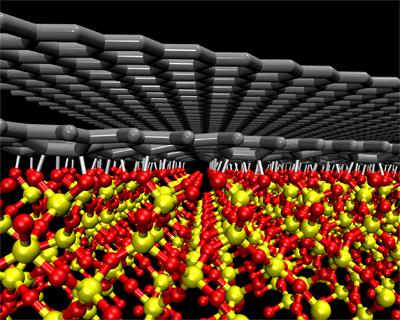Researchers tune the properties of graphene, the successor of silicon in the nanometer world, by growing it on different surfaces

Researchers from Rensselaer Polytechnic Institute in New York have discovered a new method to control the nature of graphene, bringing academia and industry one step closer to the goal of mass production of graphene-based nanoelectronics. The material Graphene, a sheet of carbon with a thickness of a single atom, was discovered in 2004 and is considered a possible successor to silicon and copper as the basic building block of nanoelectronics.
Thanks to assistance from other materials used as a substrate, researchers were able, for the first time, to demonstrate the ability to control the nature of graphene. Researcher Saroj Nayak, a professor in the Department of Physics, Applied Physics and Astronomy, along with researcher Philip Shemella determined that the chemistry of the surface on which the graphene is deposited plays a key role in determining the material's conductive properties. The findings are based on large-scale quantum mechanics simulations.
The findings show that when the graphene is deposited on a surface previously treated with oxygen, the graphene exhibits semi-conducting properties. However, when the surface is treated with hydrogen beforehand, the graphene exhibits properties of a metal.
"Depending on the chemistry of the surface on which the graphene is deposited, we are able to control the nature of the graphene from being a metal to being a semiconductor," explains the researcher. "In fact, we "tune" the electrical properties of a material so that it adapts to our needs."
Normally, when a stack of graphene nanostructures is produced, part of the graphene is metallic while the rest is a semiconductor. On an industrial scale, the researcher clarifies, it is almost impossible to separate these two types of graphene, while the production of modern graphene devices will require the existence of only one type of graphene - metallic or semi-conducting. The new method for adjusting the nature of the graphene is a key step in achieving this goal, says the researcher.
Graphene's excellent conductivity makes it a desirable material for researchers in various fields. Even at room temperature the electrons in a material move effortlessly, close to the speed of light and with only little resistance. That is, a connector made of graphene should stay cooler than a connector made of copper of the same size. Colder is better, because the heat generated by the connectors can lead to negative effects on the calculation speed of the processor and the efficiency of the computer as a whole.
The research findings were published this month in the scientific journal Applied Physics Letters in an article entitled "Electronic structure and band-gap modulation of graphene via substrate surface chemistry".

2 תגובות
Is electrical conductivity the limit to the computing power of today's processors?
How can this be a silicone replacement for commercial uses?
Surfaces one atom thick should evaporate.